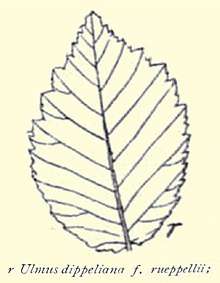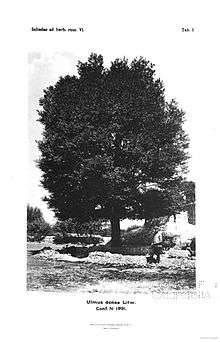Ulmus minor 'Rueppellii'
Ulmus minor 'Rueppellii' is a Field Elm cultivar said to have been introduced to Europe from Tashkent by the Späth nursery, Berlin.[2][3] Noted in 1881 as a 'new elm',[4] it was listed in Späth Catalogue 73, p. 124, 1888–89, as Ulmus campestris Rueppelli, and later by Krüssmann[5] as a cultivar.[6]
| Ulmus minor 'Rueppellii' | |
|---|---|
 Leaf-drawing of 'Rueppellii'[1] | |
| Species | Ulmus minor |
| Cultivar | 'Rueppellii' |
| Origin | Europe |
Description
'Rueppellii' was a pyramidal tree with a single stem and numerous ascending branches forming a globose or ovoid crown, much like 'Umbraculifera'.[7] The branches are slightly corky, and the branchlets pubescent, bearing small leaves similar to those of the Cornish Elm,[8] measuring 6–7 cm (2.4–2.8 in) long by 4–5 cm (1.6–2.0 in) wide, the surface likened to that of the wych elm U. glabra.[9]
Pests and diseases
Most U. minor cultivars are susceptible to Dutch elm disease, but, if not grafted, can survive through root-sucker regrowth. Specimens planted in Poland suffered from European elm scale.[10]
Cultivation
No specimens are known to survive. Three specimens supplied by the Späth nursery to the Royal Botanic Garden Edinburgh in 1902 as U. campestris 'Rueppelli' may survive in Edinburgh, as it was the practice of the Garden to distribute trees about the city (viz. the Wentworth Elm).[11] The current list of Living Accessions held in the Garden per se does not list the plant.[12] Two specimens were grown at Kew Gardens before the First World War, obtained from the Barbier nursery, France.[8] A specimen obtained from Späth before 1914, and planted in that year, stood in the Ryston Hall arboretum, Norfolk,[13] in the early 20th century.[14] 'Rueppelli' was used in urban plantings in Bydgoszcz, Poland, in the 1920s.[10] It was marketed by the Hesse Nursery of Weener, Germany, in the 1930s.[15]
In North America, one tree was planted as U. campestris 'Rueppelli' in 1897 at the Dominion Arboretum, Ottawa, Canada.[16] In the US, Ulmus Rueppelli, 'Rueppell's English Elm' (an error probably arising from the equating of U. campestris with English Elm), a "handsome compact form, growing perfectly symmetrical without pruning", appeared in the 1902 catalogue of the Bobbink and Atkins nursery, Rutherford, New Jersey.[17]
Putative specimens
In Edinburgh, an unidentified suckering Field Elm cultivar found in Links Place, Leith Links (2016), matches the description, leaf-drawing and herbarium specimen of 'Rueppellii',[18] and may be one of Späth's three. Similar elms also appear in old photographs of Tashkent.[19][20]
.jpg) Links Place elm
Links Place elm.jpg) The same
The same.jpg) Bole of same
Bole of same.jpg) Bark of same
Bark of same_(1).jpg) Leaves of same
Leaves of same_(2).jpg) Underside
Underside.jpg) Pressed autumn leaves
Pressed autumn leaves Samarae of Links Place elm
Samarae of Links Place elm Tree labelled U. densa Litv. (for comparison)
Tree labelled U. densa Litv. (for comparison)
Etymology
Uncertain; the tree is probably named either for Julius Rüppell, owner of the Peter Smith & Co nursery in Hamburg during the latter part of the 19th century,[4] or for the naturalist and explorer Eduard Rüppell.[9]
Accessions
None known.
References
- Schneider, Camillo Karl (1906). Illustriertes Handbuch der Laubholzkunde. 1. Jena G. Fischer. p. 219.
- Späth, Ludwig (1930). Späth-Buch, 1720-1930. Berlin: Self published. pp. 311–313, 351–352.
- Krüssman, Gerd, Manual of Cultivated Broad-Leaved Trees & Shrubs (1984 vol. 3)
- "Zwei neue Ulmen". Hamburger Garten-und Blumenzeitung. 37: 85. 1881.
- kiki.huh.harvard.edu
- Krüssmann, Johann Gerd (1962). Handbuch der Laubgehölze. 2. p. 535.
- Green, Peter Shaw (1964). "Registration of cultivar names in Ulmus". Arnoldia. Arnold Arboretum, Harvard University. 24 (6–8): 41–80. Retrieved 16 February 2017.
- Elwes, Henry John; Henry, Augustine (1913). The Trees of Great Britain & Ireland. 7. p. 1893. Republished 2004 Cambridge University Press, ISBN 9781108069380
- Ascherson, Paul; Graebner, Paul (1913). Synopsis der mitteleuropäischen Flora. 4. p. 566. Retrieved 16 February 2017.
- Państwowy instytut naukowo-rolniczy (1926). Prace. 1-12. Bydgoszcz (Bromberg) Poland: Pánstwowy instytut naukowo-rolniczy. Wydzial chorób róslin. p. 42. Retrieved 13 June 2017.
- Accessions book. Royal Botanic Garden Edinburgh. 1902. pp. 45, 47.
- "List of Living Accessions: Ulmus". Royal Botanic Garden Edinburgh. Retrieved 21 September 2016.
- rystonhall.co.uk/
- Ryston Hall Arboretum catalogue. c. 1920. pp. 13–14.
- Hesse, Hermann Albert (1932). Preis- und Sortenliste. pp. 96–97. Retrieved 18 January 2018.
- Saunders, William; Macoun, William Tyrrell (1899). Catalogue of the trees and shrubs in the arboretum and botanic gardens at the central experimental farm (2 ed.). pp. 74–75.
- Bobbink and Atkins, Rutherford. N.J. 1902. p. 51.
- bioportal.naturalis.nl
- "Русский Ташкент" [Tashkent elms: Russian Tashkent] (in Russian). Retrieved 2017-02-09.
- "Ташкент на старых фотографиях" [Tashkent elms:Tashkent in old photographs] (in Russian). Retrieved 2017-02-09.
External links
- "Herbarium specimen - WAG.1847045". Botany catalogues. Naturalis Biodiversity Center.
- "Herbarium specimen - WAG.1847046". Botany catalogues. Naturalis Biodiversity Center.
- "Herbarium specimen - WAG.1847047". Botany catalogues. Naturalis Biodiversity Center.
- "Herbarium specimen - L.1586964". Botany catalogues. Naturalis Biodiversity Center. Sheet described as U. carpinifolia Gled. cv. 'Rueppellii' (Späth) (Belder Arboretum specimen)
- "Herbarium specimen - WAG.1852698". Botany catalogues. Naturalis Biodiversity Center.
- "Herbarium specimen - WAG.1852699". Botany catalogues. Naturalis Biodiversity Center.